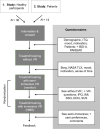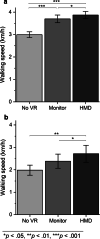Immersive virtual reality during gait rehabilitation increases walking speed and motivation: a usability evaluation with healthy participants and patients with multiple sclerosis and stroke
- PMID: 33888148
- PMCID: PMC8061882
- DOI: 10.1186/s12984-021-00848-w
Immersive virtual reality during gait rehabilitation increases walking speed and motivation: a usability evaluation with healthy participants and patients with multiple sclerosis and stroke
Abstract
Background: The rehabilitation of gait disorders in patients with multiple sclerosis (MS) and stroke is often based on conventional treadmill training. Virtual reality (VR)-based treadmill training can increase motivation and improve therapy outcomes. The present study evaluated an immersive virtual reality application (using a head-mounted display, HMD) for gait rehabilitation with patients to (1) demonstrate its feasibility and acceptance and to (2) compare its short-term effects to a semi-immersive presentation (using a monitor) and a conventional treadmill training without VR to assess the usability of both systems and estimate the effects on walking speed and motivation.
Methods: In a within-subjects study design, 36 healthy participants and 14 persons with MS or stroke participated in each of the three experimental conditions (VR via HMD, VR via monitor, treadmill training without VR).
Results: For both groups, the walking speed in the HMD condition was higher than in treadmill training without VR and in the monitor condition. Healthy participants reported a higher motivation after the HMD condition as compared with the other conditions. Importantly, no side effects in the sense of simulator sickness occurred and usability ratings were high. No increases in heart rate were observed following the VR conditions. Presence ratings were higher for the HMD condition compared with the monitor condition for both user groups. Most of the healthy study participants (89%) and patients (71%) preferred the HMD-based training among the three conditions and most patients could imagine using it more frequently.
Conclusions: For the first time, the present study evaluated the usability of an immersive VR system for gait rehabilitation in a direct comparison with a semi-immersive system and a conventional training without VR with healthy participants and patients. The study demonstrated the feasibility of combining a treadmill training with immersive VR. Due to its high usability and low side effects, it might be particularly suited for patients to improve training motivation and training outcome e. g. the walking speed compared with treadmill training using no or only semi-immersive VR. Immersive VR systems still require specific technical setup procedures. This should be taken into account for specific clinical use-cases during a cost-benefit assessment.
Keywords: Gait disorder; Head-mounted display; Motivation; Multiple sclerosis; Rehabilitation; Stroke; Virtual reality.
Conflict of interest statement
The authors declare that they have no competing interests.
Figures



Similar articles
-
Virtual reality-enhanced walking in people post-stroke: effect of optic flow speed and level of immersion on the gait biomechanics.J Neuroeng Rehabil. 2023 Sep 25;20(1):124. doi: 10.1186/s12984-023-01254-0. J Neuroeng Rehabil. 2023. PMID: 37749566 Free PMC article.
-
Immersive Virtual Reality during Robot-Assisted Gait Training: Validation of a New Device in Stroke Rehabilitation.Medicina (Kaunas). 2022 Dec 7;58(12):1805. doi: 10.3390/medicina58121805. Medicina (Kaunas). 2022. PMID: 36557007 Free PMC article.
-
Virtual Reality as a Therapy Tool for Walking Activities in Pediatric Neurorehabilitation: Usability and User Experience Evaluation.JMIR Serious Games. 2022 Jul 14;10(3):e38509. doi: 10.2196/38509. JMIR Serious Games. 2022. PMID: 35834316 Free PMC article.
-
Virtual reality during gait training: does it improve gait function in persons with central nervous system movement disorders? A systematic review and meta-analysis.NeuroRehabilitation. 2019;44(1):43-66. doi: 10.3233/NRE-182551. NeuroRehabilitation. 2019. PMID: 30814368
-
Efficacy of virtual reality-based intervention on balance and mobility disorders post-stroke: a scoping review.J Neuroeng Rehabil. 2015 May 10;12:46. doi: 10.1186/s12984-015-0035-3. J Neuroeng Rehabil. 2015. PMID: 25957577 Free PMC article.
Cited by
-
A Review of the Potential of Virtual Walking Techniques for Gait Rehabilitation.Front Hum Neurosci. 2021 Nov 3;15:717291. doi: 10.3389/fnhum.2021.717291. eCollection 2021. Front Hum Neurosci. 2021. PMID: 34803632 Free PMC article. Review.
-
The Influence of Previous Experience on Virtual Reality Adoption in Medical Rehabilitation and Overcoming Knowledge Gaps Among Health Care Professionals: Qualitative Interview Study.J Med Internet Res. 2025 Apr 30;27:e62649. doi: 10.2196/62649. J Med Internet Res. 2025. PMID: 40305102 Free PMC article.
-
An augmented reality interface to control a collaborative robot in rehab: A preliminary usability evaluation.Front Digit Health. 2023 Feb 13;5:1078511. doi: 10.3389/fdgth.2023.1078511. eCollection 2023. Front Digit Health. 2023. PMID: 36860377 Free PMC article.
-
Advances in applying somatosensory interaction technology in geriatric care: A bibliometric analysis.Int J Nurs Sci. 2024 Oct 12;11(5):571-577. doi: 10.1016/j.ijnss.2024.10.009. eCollection 2024 Nov. Int J Nurs Sci. 2024. PMID: 39698138 Free PMC article. Review.
-
Motivation as a Measurable Outcome in Stroke Rehabilitation: A Systematic Review of the Literature.Int J Environ Res Public Health. 2023 Feb 26;20(5):4187. doi: 10.3390/ijerph20054187. Int J Environ Res Public Health. 2023. PMID: 36901206 Free PMC article.
References
Publication types
MeSH terms
LinkOut - more resources
Full Text Sources
Medical

